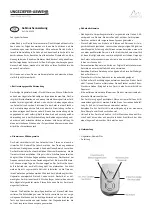
16
VEGAKON 66
Diagnostics
5 Diagnostics
5.1 Replacement of electronics
Replacing the electronics modules is no
problem, since they are subject to narrow
limits of variation and require no adaptation to
other sensor (mechanical or electrical) com-
ponents.
Before removing the electronics module, the
positions of the conductance switch, the
mode switches and the integration switch
should be noted. Set the new electronics
module to the same values. A fresh adjust-
ment to the medium is unnecessary. As soon
as you insert the sensor electronics, the
VEGAKON is ready for operation.
5.2 Simulation of switching func-
tions
With the switch positions "Test max." and "Test
min.", full immersion (max.) or empty immer-
sion (min.) can be simulated. It is not possi-
ble to move the medium. The level of the
medium does not have to be raised or low-
ered. This enables you to check the re-
sponse of the signalling and switching
systems which are controlled by VEGAKON
66. Certain parts of the sensor electronics
are also checked during the test.
Summary of Contents for VEGAKON 66
Page 1: ...Level and Pressure Operating Instructions VEGAKON 66...
Page 17: ...VEGAKON66 17 Notes...
Page 18: ...18 VEGAKON66 Notes...
Page 19: ...VEGAKON66 19 Notes...





































